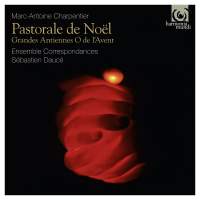Texte paru dans: / Appeared in: Harmonia Mundi |
|
|
Outil de traduction ~ (Très approximatif) |
|
|
Reviewer: Barry
Brenesal Marie de Lorraine, Duchess de Guise, requested a complex entertainment for Christmas in 1684 from the man who was in several respects her court composer, Marc-Antoine Charpentier: a motet entitled Pastorale sur la naissance de Notre Seigneur Jésus-Christ. This was to be no static, single-scene or single-emotion affair, but a complex work that might have been at least in part staged. The story of the piece is quickly told. Using a mix of Isaiah, the Gospel of St. Luke, and personal interpretation, the author (whose identity unfortunately remains unknown to us) moves from a brief description of a pastoral world in misery to an announcement to massed shepherds that Christ has been born to bring peace, light, and redemption. The parable of the infernal wolf and the sheep is worked in, but all ends in rejoicing.
Structurally, the work is closest to a latter day cantata, with multiple changes of pace, and numerous sectional divisions—or even, as in the delightfully light-stepping opening shepherds’ chorus from scene 2, “Dans ces lieuxé cartés,” multiple mini-sections within a section. The text cleverly employs successive disparate textural and expressive elements, a point that Charpentier the dramatist makes as much use of as his forces allowed. There is an argument to be made that works like this one influenced Delalande’s later motets.
It apparently pleased the Duchess greatly, for it was revived over at least two successive Christmases. That of 1685 pulled back on some of the sermon content and brought the shepherds instead to the manger, where their reactions to the Christ Child are the focus of two scenes that presumably replaced others in the original. The 1686 version adds a final scene that has the shepherds heading back to their flocks as day breaks, hailing both the rising of the physical sun and the Christ.
It is easy to understand why Marie de Guise was so charmed by the Pastorale sur la naissance. It displays Charpentier’s gift for distinctive melody, his simple but limpid recitatives, sprightly danceable rhythms, the ease with which he speaks contrapuntally, and even hints at his expressive range. (For. upbeat though it necessarily may be, there is grandeur in the final “Source de lumières et de grâce,” while the First Shepherdess’s lament, “Hélas, cette brebis si chère,” possesses a memorable, dissonant melancholy that has its descendents in numerous operas of Rameau.)
As the work itself is not long, it was easy to slot in separately the eight selections that differ in the second version, and the four that constitute the third. And with still more space available, Sébastien Daucé turned to settings of the “O” antiphons that Charpentier wrote in the 1690s for the église Saint-Louis in Paris, where he served as maître de musique. These seven pieces are preceded by O Salutaris; while the composer’s version of the wistfully affecting folksong Or nous dites Marie appears twice: once in a version for organ dividing the antiphons, and then for singers with organ at their conclusion. Their placement following the first version of the Pastorale sur la naissance startles more than a bit, given their somber mood, though the folksong eases the way into the Pastorale’s second version.
The performances are a delight. The instrumental side of Daucé’s Ensemble Correspondances on this album is a light, flexible group of 10 members, compromising winds, strings (both plucked and bowed), and keyboards. The play with great energy and a strong sense of discipline. Daucé himself is alert to the value of Charpentier’s shifting rhythmic patterns, and the importance of dance in sacred celebration. His tempos are varied, and his nine singers, uniformly excellent. If asked to single out one or two for their solos, I would point to Caroline Weynants, whose warm tone and agility I also greatly enjoyed in Keiser’s Brockes-Passion; and to high-bass Etienne Bazola, whose smooth production, dark lower reaches and bright top recall some of the celebrated French basses whose voices were preserved for us a century or more ago. This would be a fine disc for Christmas, but it is just as much a pleasure to hear the rest of the year. Highly recommended. | |
|
Support us financially by purchasing this disc from eiher one of these suppliers. Un achat via l'un ou l'autre des fournisseurs proposés contribue à défrayer les coûts d'exploitation de ce site. |
|
|
|
|
|
Cliquez l'un ou l'autre
bouton pour découvrir bien d'autres critiques de CD |
|




